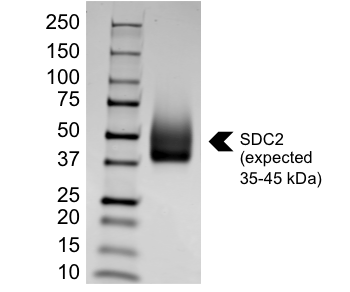Recombinant Human Syndecan-2/CD362 Protein, CF Summary
Product Specifications
Glu19-Glu144, with a C-terminal 6-His tag
Analysis
Product Datasheets
Carrier Free
CF stands for Carrier Free (CF). We typically add Bovine Serum Albumin (BSA) as a carrier protein to our recombinant proteins. Adding a carrier protein enhances protein stability, increases shelf-life, and allows the recombinant protein to be stored at a more dilute concentration. The carrier free version does not contain BSA.
In general, we advise purchasing the recombinant protein with BSA for use in cell or tissue culture, or as an ELISA standard. In contrast, the carrier free protein is recommended for applications, in which the presence of BSA could interfere.
2965-SD
| Formulation | Lyophilized from a 0.2 μm filtered solution in PBS. |
| Reconstitution | Reconstitute at 100 μg/mL in sterile PBS. |
| Shipping | The product is shipped at ambient temperature. Upon receipt, store it immediately at the temperature recommended below. |
| Stability & Storage: | Use a manual defrost freezer and avoid repeated freeze-thaw cycles.
|
Reconstitution Calculator
Background: Syndecan-2/CD362
Syndecan-2, previously known as fibroglycan or heparan sulfate proteoglycan, is a member of the syndecan family of Type 1 transmembrane proteins capable of carrying heparan sulfate (HS) and chondroitin sulfate glycosaminoglycans. The four vertebrate syndecans show conserved cytoplasmic domains and divergent extracellular portions (except for GAG attachment sites). Among the Syndecans, Syndecan-2 is most similar to Syndecan-4 (1-3). Human Syndecan-2 is synthesized as a 201 amino acid (aa) core protein with an 18 aa signal sequence, a 126 aa extracellular domain (ECD), a 25 aa transmembrane region and a 32 aa cytoplasmic tail (4). The human ECD of Syndecan-2 contains three closely-spaced consensus Ser-Gly sequences for the attachment of HS side chains. It shares 76%, 73%, 87%, 78% and 63% aa identity with the ECD of mouse, rat, bovine, canine and chicken Syndecan-2, respectively. The cytoplasmic tail has both serine and tyrosine phosphorylation sites. Addition of 20-80 disaccharides per side chain adds considerably to the size of the 22 kDa core protein. Non-covalent homodimerization of Syndecan-2 is dependent on the transmembrane domain (5). Syndecan-2 is expressed in cells of mesenchymal origin, neuronal and epithelial cells, and is the predominant syndecan expressed during embryonic development. Expression is upregulated in several cancer cell lines (6). After induction in macrophages by inflammatory mediators, Syndecan-2 selectively binds FGFbasic, VEGF and EGF (7). Syndecan-2 expressed on human primary osteoblasts binds GM-CSF and may function as a co-receptor (8). Activated endothelial cell Syndecan-2 specifically binds IL-8 and may participate in promoting neutrophil extravasation by forming a chemotactic IL-8 gradient (9). Typically, cytokine, chemokine and extracellular matrix protein binding occurs through interaction with HS side chains, but the Syndecan-2 extracellular domain can bind TGF-beta directly via protein-protein interaction (10).
- Tkachenko, E. et al. (2005) Circ. Res. 96:488.
- Oh, E.-S, and J. R. Couchman (2004) Mol. Cells 17:181.
- Essner, J. J. et al. (2006) Int. J. Biochem. Cell Biol. 38:152.
- Marynen, P. et al. (1989) J. Biol. Chem. 264:7017.
- Choi, S. et al. (2005) J. Biol. Chem. 280:42573.
- Park, H. et al. (2002) J. Biol. Chem. 277:29730.
- Clasper, S. et al. (1999) J. Biol. Chem. 274:24113.
- Modrowski, D. et al. (2000) J. Biol. Chem. 275:9178.
- Halden, Y. et al. (2004) Biochem. J. 377:533.
- Chen, L. et al. (2004) J. Biol. Chem. 279:15715.
Citations for Recombinant Human Syndecan-2/CD362 Protein, CF
R&D Systems personnel manually curate a database that contains references using R&D Systems products. The data collected includes not only links to publications in PubMed, but also provides information about sample types, species, and experimental conditions.
3
Citations: Showing 1 - 3
Filter your results:
Filter by:
-
Chain-specificity of laminin ?1-5 LG45 modules in the recognition of carbohydrate-linked receptors and intramolecular binding
Authors: Matsunuma, M;Kan, R;Yamada, Y;Hamada, K;Kanagawa, M;Nomizu, M;Kikkawa, Y;
Scientific reports
Species: Human
Sample Types:
Applications: Bioassay -
LTBP-2 has multiple heparin/heparan sulfate binding sites.
Authors: Parsi MK, Adams JR, Whitelock J
Matrix Biol., 2010-04-09;29(5):393-401.
Species: Human
Sample Types: Recombinant Protein
Applications: Binding Assay -
Expression of syndecan-2 in the amoeboid microglial cells and its involvement in inflammation in the hypoxic developing brain.
Authors: Kaur C, Sivakumar V, Yip GW, Ling EA
Glia, 2009-02-01;57(3):336-49.
Species: Rat
Sample Types: Whole Cells
Applications: Bioassay
FAQs
No product specific FAQs exist for this product, however you may
View all Proteins and Enzyme FAQsReviews for Recombinant Human Syndecan-2/CD362 Protein, CF
Average Rating: 5 (Based on 1 Review)
Have you used Recombinant Human Syndecan-2/CD362 Protein, CF?
Submit a review and receive an Amazon gift card.
$25/€18/£15/$25CAN/¥75 Yuan/¥2500 Yen for a review with an image
$10/€7/£6/$10 CAD/¥70 Yuan/¥1110 Yen for a review without an image
Filter by:





